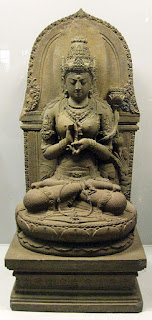The Two Entrances: A sermon by Bodhidharma plus commentary

The First Patriarch of Zen, Bodhidharma, lays out the two principles for practice in this sermon originally found in the caves of Dunhuang. The manuscript of this sermon was found amongst the documents in the Dunhuang caves and was attributed to Bodhidharma. The manuscript itself was written complied and added to by individuals and groups who looked to Bodhidharma as their guide and inspiration. This ‘adding to’ a text by those who follow in the footsteps of a patriarch was a common enough practice. It was justified by the understanding that having walked the way it was possible to elaborate a teaching in accordance with the spirit of the founder. " Many roads lead to the Path, but basically there are only two: Principle and Practice. To enter by Principle means to realise the essence through instruction and to see that all living things share the same true nature, which isn’t apparent because it’s shrouded by sensation and delusion. Those who turn from delusion back to reality, w...






